Brushes are much more important in watercolor than in oil painting. Here’s what each brush is for.
 |
| The more vertical the brush, the more flow. |
Recently a student asked me why he was carrying so many different brushes. What were their uses? This is the second part of the answer; I addressed
oil painting brushes last week.
Watercolor brushes are softer than oil-painting brushes. The most expensive are sable brushes, and unlike oil-painting brushes, the difference is worth paying for. Natural bristles combine strength with suppleness and hold more paint than synthetics. However, there are some fine synthetic brushes out there. Several of my go-to brushes are Princeton Neptunes.
Unlike oil-painting brushes, your watercolor brushes should last a lifetime, so buy the best you can afford. The only absolute rule is to never leave them standing in water. Set them down flat between brushstrokes and rinse them thoroughly when you’re done.
 |
| Made with the synthetic spalter brush, above. |
Except for squirrel mops, watercolor brushes drop more pigment the more vertically they’re held. You can use this to move from a filled area to a broken one in one brush stroke. In all the following examples except for the mop, I’ve held the brush both ways. A good general rule is to carry the vertical brush slowly and in a controlled manner; pull a horizontal brush more rapidly to get the least amount of paint contact with the paper.
The brush I used for the photo montage above is a 2″ flat synthetic mottler or spalter brush. I like this shape for both oils and watercolor. It’s a relatively inexpensive brush that gives a beautiful wash. It’s useful for covering large areas quickly, but with precise edges.
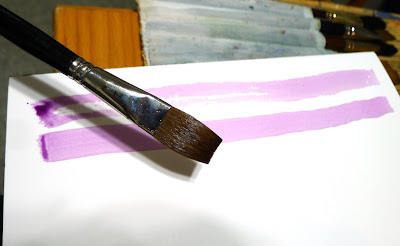 |
| A flat gives you a good even wash. Used on its side, it can give you a controlled line. |
 |
| And that would be the bright. More punch, less pigment. |
Flats and brights give you nice flat washes, but can be used to make expressive lines as well. Brights have more control and carry less paint, just as they do in oil painting. Turn them on their sides to make a controlled line. Twisting the brush while painting gives an infinite variety of shapes. So too does varying the ratio of paint and water.
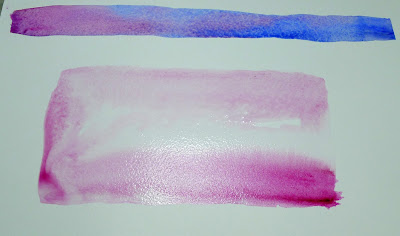 |
| You can’t do either of these things in any other medium. |
Because of the way watercolor bleeds, its brushes can be used in ways not possible in any other medium–a long blend of different pigments, or by painting a shape in clear water and then dropping pigment into it.
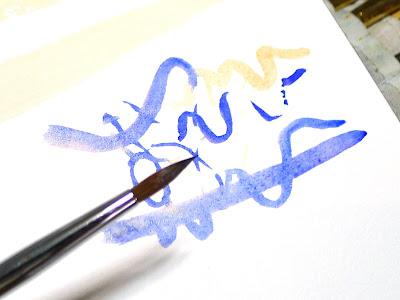 |
| Round brushes are just more lyrical than flats. |
I don’t normally carry riggers with me in either watercolor or oils. (They’re meant to paint perfect lines, and my world-view apparently doesn’t have many perfect lines in it.) Most of my line work is done with rounds. They do not give as much control on long lines, but they are very expressive.
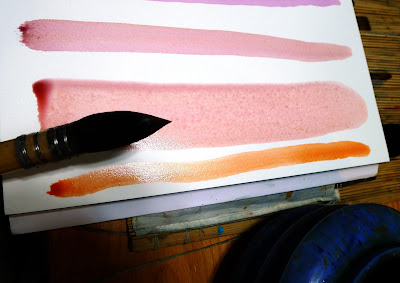 |
| A mop brush makes a perfect wash, but it does so much more as well. |
Squirrel mops are the most uniform wash brush you can use. It’s virtually impossible to make them skip, so use them where a lovely flat wash is a goal.
 |
| Mop brush on very textured paper. |
But a good mop can also point, hold vast amounts of paint and sweep across the paper in style.
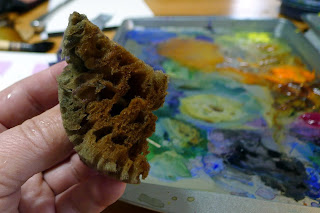 |
| One of my favorite tools, a natural sponge. |
Natural sea sponges are multi-purpose painting brushes. Use them to apply or remove paint. They can be as subtle or bold as you wish.
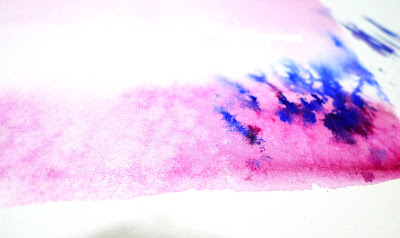 |
| Paint lifted (left) and applied (right) with a sponge. |
Your brushwork contributes immeasurably to the quality of your painting. Don’t dab or be diffident; plan your strategy and then execute it with boldness. To do this, of course, you have to practice.





